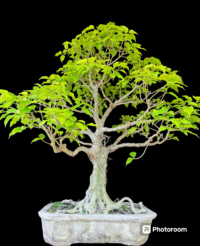Imli Tamrind Bonsai
Detailed Care Instructions for Imli Tamrind Bonsai :
Watering:
- For young plants, regular watering is essential. Water daily until the excess water drains through the pothole.
- Mature plants require less frequent watering. However, never let the topsoil dry out completely. Check for moisture by gently touching the topsoil; if it’s dry, add water.
Humidity:
- Tamarind plants thrive in humid and hot, dry climates, suitable for tropical regions.
- In cold or freezing temperatures, keep the plants indoors near a warm zone. Placing them near a window with a tray of pebbles and water beneath the pot can help maintain humidity and prevent the plant from drying out.
Fertilizing:
- Apply fertilizers monthly or bi-monthly, ensuring they have acidic properties to promote healthy growth.
Repotting:
- Repot the tamarind bonsai every 2-3 years to refresh the soil and provide more space for root growth.
Pruning:
- Regularly prune and wire the bonsai to maintain its shape. In the first few years, frequent pruning is necessary to strengthen the trunk.
Insects and Diseases:
- Tamarind bonsai may face issues like aphids, caterpillars, and powdery mildew. Monitor the plant regularly and treat any problems promptly.
- Repotting:
- Repot the bonsai plant every 2-3 years.
- During repotting, prune extra roots to maintain the bonsai’s size and health.
- Replace the existing soil with a fertilized soil mixture to balance soil fertility.
- Regular pruning and pinching are essential to maintain your tamarind tree as a bonsai.
Pruning:
- As the tamarind plant matures, it forms a dome shape, providing shade below.
- To control branching and maintain stability, prune branches that grow larger than the trunk.
- Ensure branches start from a single central trunk and are spaced evenly.
- When pruning, always clip branches at an angle, facing up or down, never horizontally.
- Continually trim new branches to strengthen the trunk before allowing major lateral branches to spread.
- Remove new branches that cross and interrupt the growth of older branches.
- Pro Tip: Dip pruning tools in ethanol or isopropyl alcohol between cuts to prevent the spread of diseases.
Insects and Diseases:
- Common pests include aphids and caterpillars.
- Powdery mildew, caused by a fungus, can also affect the plant.
- Trim off infected sections if mildew spreads to save the remaining plant.
- Use pesticides and fungicides to prevent future fungal damage.
Watering:
- For young plants, regular watering is essential. Water daily until the excess water drains through the pothole.
- Mature plants require less frequent watering, but never let the topsoil dry out completely. Check for moisture by gently touching the topsoil; if it’s dry, add water.
Humidity:
- Tamarind plants thrive in humid and hot, dry climates, suitable for tropical regions.
- In cold or freezing temperatures, keep the plants indoors near a warm zone. Placing them near a window with a tray of pebbles and water beneath the pot can help maintain humidity and prevent the plant from drying out.
Fertilizing:
- Apply fertilizers monthly or bi-monthly, ensuring they have acidic properties to promote healthy growth.
By following these care instructions, you can ensure your tamarind bonsai remains healthy and vibrant, adding beauty to your indoor space.




Reviews
There are no reviews yet.